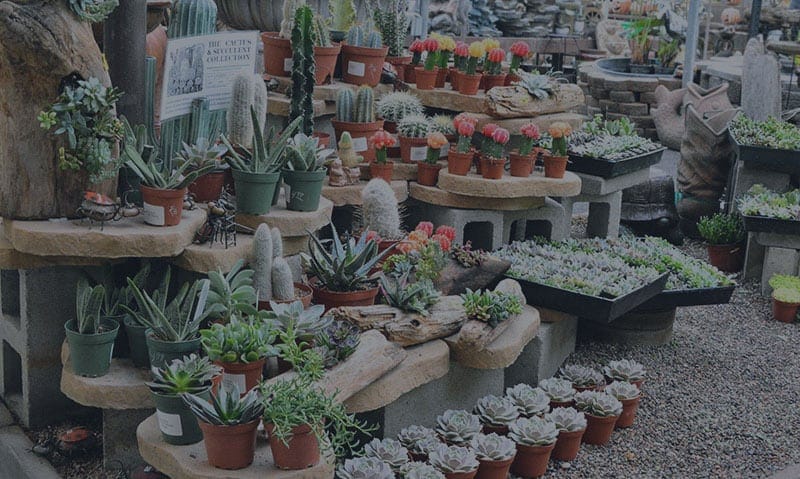Newsletter Articles
How to Care for Protea (and Their Relatives)
By Richard Flowers, ACCNP-Green Thumb Nursery-Ventura
Did you know that Protea is related to the Macadamia, how delicious is that? Protea have been in existence for over 80 million years, making them one of the oldest flowering plants in history. In fact, they overlapped with dinosaurs for at least 20 million years. They are related to other plants that are common to the floral trade for their long lasting cut flowers in bouquets. Their floral displays range from pincushions (Leucospermum) and cones (Leucadendron). Most of these plants thrive on almost neglect, low water, low maintenance, and in fact if you have too good of a soil or fertilize in some cases, they will not thrive. Lets meet some of the members and discover the differences and similarities between them. You will also discover how to keep them thriving in your landscape.
Whether it be a Protoea, Leucadendron or Leucospermum, many people seem to get confused between them and do not know the difference. They call them all Proteas however they are different but yet they are the same in some regards. All three species belong to the same family of plants called Protacea. All of them wonderfully attract butterflies and humming birds. Proteas, Leucodendrons, and Leucospermems are all native to South Africa and most of them have similar care, soil requirements, and can thrive in our dry, Mediterranean climate. I will explain in more detail about these characteristics later but first I want to reveal the differences between them so you can have a better understanding and make wiser plant selections.
Leucadendrons have much smaller flowers than their Leucospermum and Protea counter parts. Their main virtue happens to be their colorful modified leaves called bracts. A bract is a modified leaf arising below a flower. These bracts are oftentimes called “flowers” by novices. These bracts are produced in the form of a cone, hence the common name “ Cone Bush” and this is the common name I will use going forward.
The bracts are displayed on the tips of the stems during their glory which is usually late winter into spring. These colorful structures usually represent themselves in shades of of red, yellow or orange depending on the variety of which their are several. Male and female flowers are borne on separate plants. The male Cone Bush produce conelike flower clusters that sit above the colored foliage and resemble giant daisies. Female flower clusters on the other hand, are not as showy and develop into conelike seed clusters. Most varieties for sale are male. When not in color, Cone Bushes are noted for their neat, compact, almost formal looking foliage. Foliage colors can range form multi colored, chocolate to olive or grey green. In general, they have slender stems and are bushy in nature with leaves that are hairy. The leaves are more decorative than their Protea and Leucospermum counterparts. With that being said, Cone Bushes are a prettier plant most of the year and have a softer texture than the others. Although their “flowers” are not as extravagant as Proteas and Leucospermums, their colorful bracts are showy nonetheless and can be used in flower arrangements. They are attractive year – round both for the landscape and butterflies / humming birds.
The Leucospermum most redeeming quality is the blossom which make excellent cut flowers and are oftentimes used in the florist trade. Their flowers are usually large, rounded in shape with numerous long, slender, tubular thistle-like stalks arising from the center that forms a pinhead or pincushion hence the common name, Pincushion. This exotic looking flower blooming cycle usually peaks in winter and early spring but can start earlier if conditions are optimum and can last up to 6 months, Incredible isn’t it? Their foliage is oval in shape, the texture is coarse, usually leathery, narrow, and crowed on thick and heavy stems. Leaf colors range from grey to grey green tones and flowers in the shades of red, yellow or orange depending on the variety of which their are many. Butterflies and humming birds adore these plants.
Like that of Pincushion the Protea is most noted for its spectacular flower. The flower is borne at branch ends and consist of tight clusters of tubular inflorescences surrounded by colored bracts that resemble a large very colorful Artichoke flower and is most common in the floral industry becuase they hold their color for weeks and retains their shape even after fading. The leaves are leathery and often edged in red and held on thick, heavy stems. Proteas are also called “sugar bushes” due to their production of copious amounts of nectar needed for humming birds and butterflies. Depending on the variety of which their are numerous, the flowers come in similar shades of colors as the two other species previously mentioned.
Pincushions, Protea, and Cone Bushes are native to the Southern Hemisphere and in their native habitat they are fire adapted chaparral plants. All require full sun, six hours or more and are fine in the fog. Most species tolerate light frost, with warm to hot summers and cool nights in winter with ideal temperatures between 40 and 95 degrees f. , and prefer dry conditions. They often struggle in high humidity environments. Only a few selections survive below 20 degrees f. With that being said, coastal areas are ideal for growing these plants. In inland areas they thrive equally as well due to hot summers provided the winter does not get excessively cold.
In their native habitat they grow in poor soils. They have specialized proteoid (Protea)roots that form an absorptive surface produced in the leaf liter and shrivel up at the end of the growing season which increases the plants ability to access scarce water and nutrients. These roots are an adaptation to growing in poor, phosphorus-deficient soils by exuding carboxylates that mobilize previously unavailable phosphorus. Their succulent, proteoid roots make them very forgiving as container plants, tolerating erratic or inadequate watering very well, these roots are amazing in that since, however it is not advisable to disturb these delicate roots when gardening or planting them. When planting, I recommend to remove the container it is planted in from the root ball and gently placing the plant in the planting hole taking care not to touch the roots. Be very careful when weeding or gardening around said plants to minimize root damage. These plants prefer good drainage, sandy, rocky, acidic, low-nutrient soils.
These special plants are phosphorus intolerant and should not be fertilized. Phosphorus is the middle number on a fertilizer container. The first number is Nitrogen, and the third number is Potassium. Fertilizers that are high in Phosphorus and Calcium can badly damage or even kill the plant. Phosphate toxicity is characterized by yellow then blackened leaves then death. Gypsum should be avoided unless Calcium is not present. Calcium along with Phosphorus can be detrimental at even ‘normal’ soil levels.
Adding Iron Sulfate or Epsom Salts (Magnesium Sulfate to lower the soil pH is recommended. Apply at a low strength and infrequently and feed at 1/8 – 1/4 the rates of other plants. If fertilizing, you should use fertilizers with almost no phosphorus and low potassium and nitrogen. If the leaves become yellow (iron chlorosis) you may need to apply chelated iron foliar spray and root drench in the spring. Adding soil sulfur to lower the PH can be helpful. Ideally the soil should be acid with a Ph around 4.5-5.5.
Excellent drainage, keeping the roots cool, and protection form drying winds is a must. Providing good air circulation ( not crowded) around each plant is beneficial to decrease the likelihood of foliar funguses especially in coastal areas where fog and cool weather is present. In other words, have plenty of space around each plant where they are not touching each other or in contact with objects or other plants, they done like to be crowded. When planting in the ground, they prefer deep, infrequent watering. Once they
are established they only need occasional summer( usually once per month) water. When watering, take care to apply water away form the crown (the area where the main stem of the plant meets the ground) by irrigating where all the branches and leaves come out and never over water. In the coldest coastal areas, no summer water.
Although they are somewhat drought-tolerant, it benefits from regular water during warm, dry weather. Water early in the morning so the plants have all day to dry before the arrival of cooler temperatures in the evening, helping to prevent leaf and stem fungi from forming.
They also thrive in pots, and should be planted in cactus mix, perlite, pumice or scoria, and not allowed to go completely dry between waterings. Adequate drainage holes on the bottom of the container is critical and don’t use a saucer under the pot. When planting in the ground, they require a sandy soil which is well-drained. If the ground tends to be more clay or is not well drained, it is advised to amend the soil with Pumice for better drainage. Agricultural-grade gravel or cactus mix can also be used as well. Planting on a mound or slopes for better drainage is also a good practice. Mulching is very important because it reduces water evaporation substantially, improves the structure of the soil making it drain better, and provides some acidity to the soil as it breaks down.
You can use Cone Bush, Pincushion, and Protea in the landscape along with other Australian, South African, and Mediterranean plants like Aloe, Coast Rosemary, Flax, Grasses, Kangaroo Paw, Lions Tail, Tea Tree, Acacia , Bottle Brush, South African bulbs, and Grevillea to create a low maintenance, water thrifty, and pollinator paradise garden because all these plants grow harmoniously together.
I hope these tips and information will provide you success in growing this outstanding and unique plants. Check out your favorite Green Thumb Nursery, we have lots of cool and interesting products for all your gardening endeavors.
Do you like what you see? Sign up for our weekly newsletter to get content like this every week!


